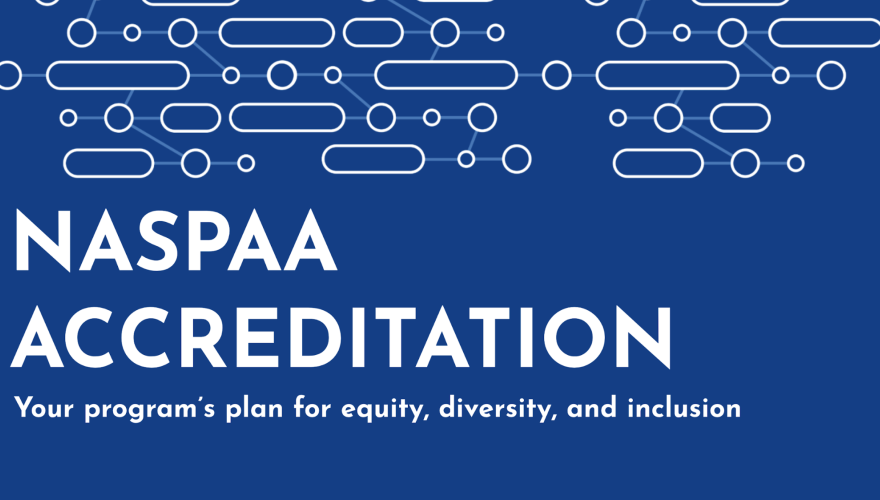Thinking Strategically about Diversity and Inclusion
Infusing diversity and inclusion into strategic planning ensures programs promote public service values through goals and objectives that support students and faculty to demonstrate respect, equity, and fairness in engaging with citizens and fellow public servants. Using a strategic lens allows programs to identify, develop, and advance mission-based efforts that are sensitive to unique national, regional, and/or local contexts. Programs are encouraged to bring together program stakeholders – students, faculty, alumni, employers – to integrate initiatives that promote a climate of inclusiveness and cultural competency. Programs should strive to ensure that students can apply their knowledge, understanding, and problem solving abilities in new or unfamiliar environments, and within broader or multidisciplinary contexts related to public service.
The benefits of ensuring a diverse faculty and student body and/or attaining an inclusive climate, however, are not automatic. Programs must systematically, deliberately, and intentionally emphasize diversity and inclusion to ensure goals are met and sustained. Thus, it is important that programs create a culture of accountability through established measures and indicators to validate that diversity efforts consistently contribute to a program’s success. Tracking, collecting, and critically examining diversity efforts can contribute to a program’s success through discussion, reflection, and evidence-based decision-making. Engaging in strategic planning adds an incredible value to programs as it allows them to plan, act, assess, and improve where necessary. To learn more about COPRA’s expectations for diversity and inclusion, refer to COPRA Policy Statements and explore resources related to Standards 3 and 4.
Diversity and Inclusion in Accreditation
Throughout the accreditation process, COPRA relies on programs to articulate dimensions of diversity as they relate to the program’s unique context. COPRA is sensitive to the specific goals, values, and mission of a program, as well as the environment in which it operates, and expects programs to provide all students a supportive educational climate. Because graduates of NASPAA accredited programs across the world are expected to be leaders in promoting public service values and protecting the public interest, it is particularly important they be prepared to communicate and interact productively with a diverse and changing workforce and citizenry.
While public service values are emphasized across the NASPAA Accreditation Standards, diversity and inclusion are most explicitly highlighted through three Standards:
- Standard 3.2 (Faculty Diversity),
- Standard 4.4 (Student Diversity), and
- Standard 5.1 (Universal Required Competencies).
Together, these standards ensure programs promote mission, public service values, diversity, and inclusion not only through their recruitment, retention, and support of faculty and students, but through graduate competency: the ability to communicate and interact productively with a diverse and changing workforce and citizenry. For more detailed information on these, and other standards, please visit Standard-by-Standard guidance.
In its implementation of Standards 3.2 and 4.4, COPRA seeks substantial evidence regarding programmatic efforts to promote diversity and a climate of inclusiveness, especially demonstrable evidence of good practice, a framework for evaluating diversity efforts, and the connection to the program’s mission and objectives. COPRA expects programs to demonstrate how they “promote diversity and a climate of inclusiveness” in a strategic diversity plan, developed with respect to a program’s unique mission and environment. Throughout the development process, it is recommended that programs take their unique context into consideration, including mission, goals, geographic location, and internal and external climate environments, as well as students.
Tracking strategies and conducting periodic reviews of existing policies are also important ways programs can ensure that diversity efforts align with a program’s goals, objectives, and mission. Learn more about how to craft a Diversity Plan by listening to COPRA’s Diversity Plans: Examples and Guidance for Development, referring to guidance from this workshop presented at NASPAA in 2017, or by exploring peer examples of Diversity Plans.
Diversity Resources
While results show that MPA and MPP programs have diversified and improved certain dimensions of diversity over the years (see NASPAA’s 2013 Diversity Report), there are still opportunities for greater improvement and inclusion. The following webpages provides examples of diversity-related strategies and highlight other resources that may be useful for programs to employ, when considering how to best promote diversity and a climate of inclusiveness within their unique context. The list of resources is not meant to be comprehensive, rather it is intended to serve as a starting point for discussion, future research, and potential practices. Given the many dimensions of diversity, which vary within and across countries, COPRA recognizes that the practices adopted by one program may not work well in another and does not endorse any specific strategy; instead, it encourages programs to actively and strategically engage with students and stakeholders. When exploring potential strategies, it is important to consider the unique context and mission of the program, as the effectiveness of strategies may vary based on the program’s local, regional, or national environment.


